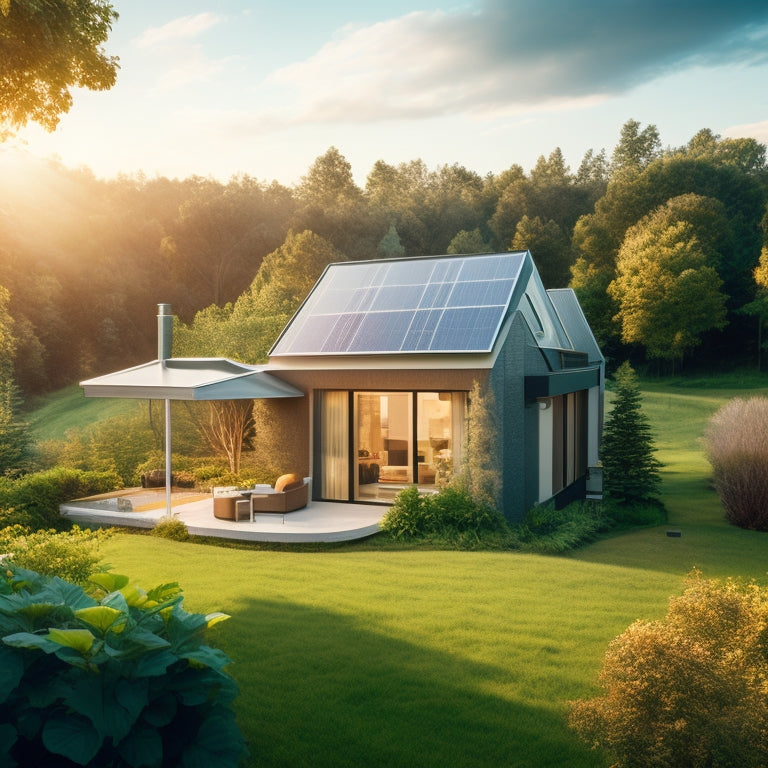
7 Ways to Maximize Home Power Independence
Share
By optimizing your home's energy usage, choosing the right solar panels, and implementing efficient energy storage systems, you'll take significant steps towards maximizing home power independence. Consider smart home automation integrations, energy-harvesting window solutions, and DIY solar installation strategies to further reduce your reliance on the grid. Don't forget to prioritize monitoring and maintenance essentials to guarantee your system runs efficiently. As you investigate these strategies, you'll uncover even more opportunities to tailor your approach and accelerate your expedition towards complete energy autonomy - and that's just the beginning of your path to total independence.
Key Takeaways
- Optimize home energy usage by conducting energy audits, prioritizing upgrades, and implementing load management to reduce waste and consumption.
- Invest in high-efficiency solar panels with ratings above 20% and consider durable options with high IP ratings and long warranties.
- Implement energy storage systems like battery backup solutions and generators to ensure energy resilience during power outages and transition to renewable energy sources.
- Integrate smart home automation systems for remote monitoring, automated lighting control, and optimized heating and cooling to maximize energy independence.
- Regularly monitor and maintain solar panels, electrical connections, and wiring to ensure optimal performance and extend system lifespan.
Optimize Your Home's Energy Usage
Efficiency is the cornerstone of home power independence, and optimizing your home's energy usage is a vital step towards achieving it. You must identify areas of inefficiency to reduce energy waste and minimize your reliance on the grid.
Conducting energy audits helps you pinpoint energy-hungry appliances and systems, allowing you to prioritize upgrades and replacements. For instance, assessing your energy needs through a thorough home assessment can help you identify areas of improvement.
Additionally, selecting high-efficiency solar panels with durable construction can also contribute to maximizing your home's power independence. Load management is also essential, as it enables you to allocate energy resources effectively, shifting non-essential loads to off-peak hours.
Choose the Right Solar Panels
When selecting solar panels, you'll want to assess panel efficiency, which is the percentage of sunlight converted into electricity.
Look for high-efficiency panels that can generate more power per hour of sunlight. Additionally, consider the importance of deep cycle battery selection for peak energy storage and the role of maintenance-free designs in enhancing operational reliability.
You should also consider panel durability, evaluating factors like warranty length, weather resistance, and degradation rates to guarantee your system lasts for decades.
Assess Panel Efficiency
Frequently, homeowners find themselves overwhelmed by the numerous options available in the solar panel market, making it essential to carefully evaluate panel efficiency before making a purchase.
You need to understand that different solar panel types have varying energy conversion rates, affecting your overall energy output. To make an informed decision, you should look for panels with high efficiency ratings, typically above 20%. This guarantees you're getting the most energy possible from the sun's rays.
Additionally, consider the temperature coefficient, which indicates how well the panels perform in high temperatures. By evaluating these factors, you'll be able to choose the most efficient solar panels for your home, maximizing your energy independence.
Consider Panel Durability
Your solar panel investment's long-term performance depends on the durability of the panels themselves. A longer panel lifespan translates to more years of generating electricity and maximizing your return on investment. Weather resistance is also vital, as solar panels are exposed to various environmental conditions.
| Panel Durability Factors | Key Considerations |
|---|---|
| Weather Resistance | Look for panels with high IP ratings (e.g., IP67) and UV-resistant materials |
| Panel Lifespan | Opt for panels with warranties of 25 years or more |
| Frame and Mounting | Choose panels with anodized aluminum frames and sturdy mounting systems |
When choosing solar panels, prioritize durability to guarantee a reliable and long-lasting energy source for your home.
Efficient Energy Storage Systems
You're now considering efficient energy storage systems to maximize your home's power independence.
Battery backup solutions are an essential component, allowing you to store excess energy generated by your solar panels during the day for use during the night or during power outages.
With advanced tech in systems like Sonnen Eco and Tesla Powerwall promoting sustainable living, you can optimize your energy usage and reduce your reliance on the grid.
Battery Backup Solutions
With the rise of renewable energy sources, homeowners are increasingly looking for efficient ways to store excess energy generated during the day for use during periods of low energy production or power outages.
You can achieve this through battery backup solutions, which provide energy resilience when the grid goes down. Lithium batteries, paired with solar inverters and charge controllers, offer an efficient energy storage system.
Grid-tied systems allow you to sell excess energy back to the grid, while off-grid solutions provide complete independence.
Effective energy management is essential to maximizing your battery's lifespan and minimizing installation costs.
Consider pairing your battery backup with a backup generator for added security.
Energy Savings Potential
Regularly, homeowners who invest in battery backup solutions reap significant energy savings benefits.
By conducting an energy audit, you can identify areas to optimize your energy consumption patterns. This might involve making lifestyle changes, such as using energy efficient appliances, and investing in renewable sources like solar or wind power.
Utility incentives can also help offset the costs of these upgrades. With efficient energy storage systems, you'll enjoy financial savings and move closer to grid independence.
Smart Home Automation Integrations
Integrating smart home automation systems into your power-independent abode can greatly enhance your control and efficiency.
You'll be able to remotely monitor and adjust various aspects of your home's energy usage. For instance, smart thermostat integration allows you to optimize your heating and cooling systems, reducing energy waste and saving you money.
Automated lighting control is another key feature, enabling you to schedule and dim lights to minimize energy consumption.
These integrations can be seamlessly connected to your existing power-independent systems, providing real-time observations and automated actions to optimize your energy usage.
Energy-Harvesting Window Solutions
Efficiency converges with innovation in energy-harvesting window solutions, which convert your home's windows into power-generating assets.
These state-of-the-art technologies seamlessly integrate into your existing windows, providing a sleek and modern aesthetic.
You can:
- Harness solar energy with transparent photovoltaics or solar window films that generate power while still allowing light to pass through.
- Optimize energy efficiency with smart window technology that adjusts tint and reflectivity to minimize heat gain and loss.
- Integrate shading solutions that reduce glare and heat while maximizing natural light.
- Mount turbines on windows to capture wind energy, further increasing your home's power independence.
DIY Solar Installation Strategies
As you've examined innovative energy-capturing window solutions, it's time to take the next step: utilizing the power of the sun directly with DIY solar installation strategies. To maximize your energy independence, consider the following key factors:
| Solar Panel Placement | Grid Connection Options | Benefits |
| Roof-mounted solar panels | Grid-tied system | Highest energy output |
| Ground-mounted solar panels | Off-grid system | Flexibility in placement |
| Solar carport or patio cover | Hybrid system | Aesthetically pleasing |
When deciding on solar panel placement, consider your roof's size, orientation, and shading. For grid connection options, choose between grid-tied, off-grid, or hybrid systems, depending on your energy needs and budget. By carefully planning your DIY solar installation, you'll be well on your way to achieving maximum home power independence.
Monitoring and Maintenance Essentials
While your DIY solar installation is generating clean energy, you'll want to keep a close eye on its performance to guarantee peak output and identify potential issues.
Regular monitoring and maintenance are vital to confirm your system operates efficiently and effectively. Here's what you need to do:
-
Schedule regular performance tracking: Use solar monitoring systems to track your energy production and identify areas for improvement.
-
Create a maintenance schedule: Set notifications for tasks like cleaning panels, inspecting connections, and performing energy audits.
-
Stay updated on troubleshooting tips: Follow industry experts and manufacturers' guidelines to diagnose and fix common issues.
- Plan for system upgrades and professional inspections: Stay ahead of technology advancements and consider professional inspections to optimize your system's performance.
Frequently Asked Questions
Can I Sell Excess Energy Back to the Grid?
You can sell excess energy back to the grid through net metering benefits, which allow you to offset your consumption and receive credits, and energy buyback programs, which purchase excess energy from you at a predetermined rate.
How Do I Ensure System Safety During Power Outages?
When the grid goes down, you'll want to guarantee your system's safety; you're doing this by performing regular system maintenance, investing in reliable generator options, and installing necessary safety features to prevent backfeeding and electrical shock.
Do Solar Panels Work During Cloudy or Rainy Days?
Can solar panels really shine on gloomy days? Yes, they can! Although solar efficiency takes a hit during cloudy conditions, you'll still generate some power, albeit reduced, thanks to advanced panel technology that optimizes energy collection in low-light environments.
Are Energy Storage Batteries Recyclable at End-Of-Life?
You'll be glad to know that energy storage batteries are recyclable at end-of-life, and you can opt for responsible battery disposal methods that minimize environmental impact, ensuring a sustainable energy future.
Can I Expand My System as Energy Needs Increase?
As you adapt to changing energy needs, you can seamlessly upgrade your system, integrating new components and optimizing energy efficiency, ensuring a customized solution that scales with your requirements, allowing for flexible system upgrades.
Related Posts
-

Top Camping Water Bottles for Adventure
When you're out adventuring, picking the right camping water bottle is essential for staying hydrated. Look for durab...
-

Replacing Old Appliances With Sustainable Alternatives
Replacing old appliances with sustainable alternatives can change your home into an energy-efficient space. Not only ...
-

Cost of Home Solar Battery
You're looking to invest in a home solar battery to reduce your grid reliance, but you're curious about the cost. The...


